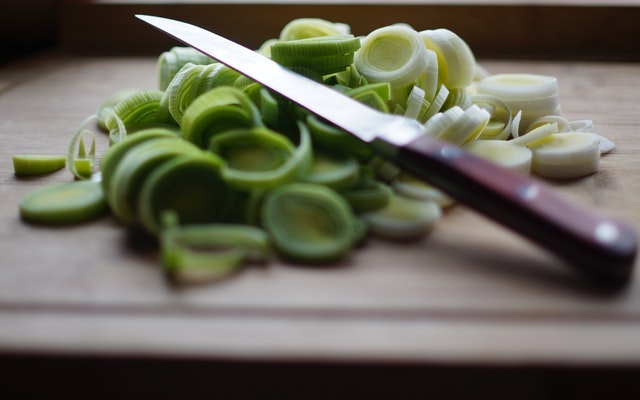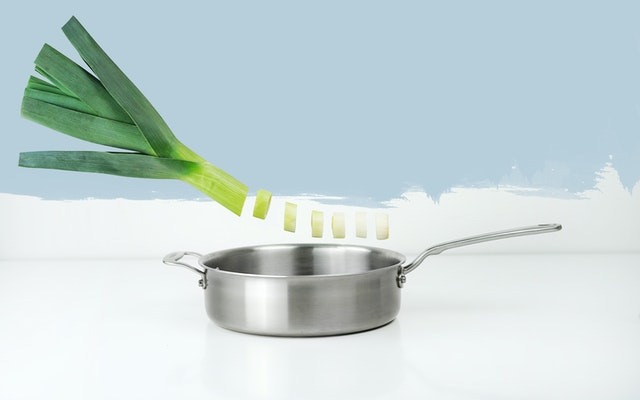Leek, source of antioxidants and vitamins.
Leek is in the same family as onions and garlic. It is a resistant vegetable that can be found all year round on market stalls. Its subtle and delicate flavor is the perfect addition to soups and salads. It is currently the ninth most consumed vegetable in Europe.
Leek characteristics
• Low in calories.
• Rich in fiber.
• Source of antioxidants.
• Source of vitamin C and B9.
• Protective effect against certain cancers.
Nutritional and caloric values of leek
For 100 g of cooked leek:
| Nutrients | Average content |
| Energy | 25 kcal |
| Water | 92 g |
| Protein | 1.1 g |
| Carbohydrates | 3 g |
| Fat | 0.2 g |
| Dietary fiber | 3.2 g |
| Calcium | 25.6 mg |
| Copper | 0.12 mg |
| Iron | 0.34 mg |
| Iodine | <10 µg |
| Magnesium | 8.45 mg |
| Manganese | 0.075 mg |
| Phosphorus | 20 mg |
| Potassium | 151 mg |
| Selenium | <10 µg |
| Sodium | 5.8 mg |
| Zinc | 0.1 mg |
| Beta-Carotene | 94 µg |
| Vitamin E | 0.5 mg |
| Vitamin K1 | 25.4 µg |
| Vitamin C | 1.3 mg |
| Vitamin B1 or Thiamine | <0.05 mg |
| Vitamin B2 or Riboflavin | <0.05 mg |
| Vitamin B3 or PP or Niacin | <0.05 mg |
| Vitamin B5 or Pantothenic acid | <0.05 mg |
| Vitamin B6 | 0.06 mg |
| Vitamin B9 or Total Folate | 21.2 µg |
Leek is low in calories at 25 Cal / 100 g. Not rich in vitamin C but rich in beta-carotene and fiber.
The benefits of leeks: why eat them?
The nutritional benefits of leeks are numerous and not insignificant.
Rich in water and therefore diuretic
The leek is rich in water which allows it to participate in our daily water needs. Rich in potassium and low in sodium, leeks play an important diuretic role.
Source of fiber
Leeks are rich in fibers which will help stimulate and regulate intestinal transit.
Stimulates the immune system
Leeks are a source of vitamin C which stimulates the immune system, participates in the formation of collagen and the proper functioning of the nervous system, and stimulates the absorption of iron.
Rich in antioxidants
It contains sulfur compounds and antioxidants which allow it to prevent certain cancers.
B vitamins
Leek is a source of vitamin B6 which plays a role in energy, the nervous system, protein synthesis, the formation of red blood cells and the reduction of fatigue.
Source of vitamin B9, it ensures cell renewal, very interesting for pregnant women for the development of the fetus, and in growing children, as well as for convalescent people.
What the nutritionists say about leek
Leeks are packed with vitamins and minerals. It is better to steam it rather than in water in order to preserve as much minerals and vitamins as possible during cooking.
Leek green is not to be neglected because it is very interesting from a nutritional point of view, especially with its beta-carotene intake.
Choosing the right leek
When harvested, the leek is composed of sheathing leaves forming at their base a cylinder of which the buried part, white and tender, is the most appreciated.
Leek identity card
• Family: Alliacées.
• Origin: Middle East.
• Season: between September and April.
• Color: green and white.
• Flavor: delicate.
The different varieties
The varieties depend on the time of harvest. Leeks harvested between early May and early July are called early leeks. They are thin and small in size, while the leeks harvested in autumn and winter are larger in size.
Purchase of leek
The stalk of the leek should be straight, fleshy, firm, shiny white, without brownish spots. The leaves should be very green, not withered, yellowed or dried out.
Keep it well
In the refrigerator: At temperatures near freezing and high relative humidity, leeks can be stored for two to three months. Its leaves will likely turn yellow, but the white will remain healthy. On the other hand, the small early leek can only be kept for one or two weeks in the refrigerator.
In the freezer: cut into slices and blanch for a few minutes in boiling water before freezing them. Remember to freeze some of the green leaves for the broths.
Leek preparation

Photo credit: Pexels
There are different ways to cook leeks.
How to cook it? How to match it?
Preparation:
• First remove the first peel and cut the root.
• Cut the leek in four starting from the tail up to halfway up the white and wash with plenty of water, removing sand and soil.
• Cut into sections, slices, or diagonals. To cut into julienne strips, cut into sections, split and slice lengthwise. Leek greens are much more fibrous than the white, so cut them finely before adding them to cooked dishes. If you prefer not to prime the green part, reserve it for the broths.
Contraindications and allergies
Leek allergy is rare but it is not recommended in cases of urolithiasis.
Urinary stones
Some people may be advised to eat a diet restricted in oxalates to prevent recurrence of kidney or bladder stones (also called urolithiasis). Oxalates are compounds found in many foods, including leek. These people are therefore not recommended to consume it.
Allergy
Reported cases of leek allergy are rather rare. However, a person who is allergic to other vegetables in the alliaceae family may react to eating leeks. Indeed, cross reactions with garlic, onion, chives and leek are likely to occur and are possibly caused by an allergen common to these vegetables. A person with an allergy to any of these foods could therefore also be allergic to another food in this family.
If you know more informations about leek like these, Share them with us.

